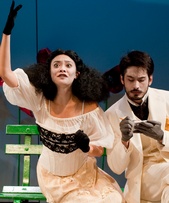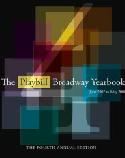SITE GUIDE
SEARCH
REVIEWS
REVIEW ARCHIVES
ADVERTISING AT CURTAINUP
FEATURES
NEWS
Etcetera and
Short Term Listings
LISTINGS
Broadway
Off-Broadway
NYC Restaurants
BOOKS and CDs
OTHER PLACES
Berkshires
London
California
New Jersey
DC
Connecticut
Philadelphia
Elsewhere
QUOTES
TKTS
PLAYWRIGHTS' ALBUMS
LETTERS TO EDITOR
FILM
LINKS
MISCELLANEOUS
Free Updates
Masthead
A CurtainUp Review
The Seagull: A Comedy in 4 Acts
| We have to show life not the way it is, or the way it should be, but the way it is in dreams — Konstantin
|

Tiffany Villarin and Marcus Ho
(Photo: William P. Steele) |
In director Gia Forakis' inventive reimagining of Anton Chekhov's The Seagull, she tips the production towards the play's subtitle: A Comedy in 4 Acts. In her director's notes, she argues that the style that modern audiences have come to view as "Chekhovian" — dark, morose plotlines and weighty, naturalistic acting— was not Chekhov's intention at all. Instead, he meant for this play, which premiered in 1896, to be a comedy, and not tethered to the grim performances made famous by Stanislavski's seminal interpretations of Chekhov's work.
To parse the comic from the tragic, Forakis has created a tightly wound, vaudevillian world for the eccentric band of characters, who pass the time together at a country house over several years. With its wonderfully acted performances and astute direction, this vibrant production is certainly unlike any Chekhov you've seen before, and it makes one thing bracingly clear: you can take the Chekhov out of the tragedy, but you can't take the tragedy out of the Chekhov.
A selection of the second annual National Asian American Theater Festival and a production of the National Asian American Theatre Company (NAATCO), this Seagull features an all-Asian cast. Although the characters are saddled with Russian names that are thick with consonants and thoroughly accented (try saying "Semyon Semyonovich Medvedenko" quickly three times in a row), the trick of Forakis' production lies in her focus on archetypes. These characters are drawn so broadly and are so easily recognizable that, eventually, neither names nor race matter much at all.
Consider the major protagonists and their crisscrossed affections: Irina Nikolayevna Arkadina, an aging, melodramatic actress with an ego like an oversized piece of costume jewelry, dotes on the brooding novelist Trigorin; her son, the temperamental, melodramatic Konstantin, writes and directs plays while writhing in emotion over his love for a neighbor's daughter, Nina; the wide-eyed ingénue, however, longs for the affection of Trigorin; while Masha, the daughter of the couple who manage the farm, chases after Konstantin. Add to these unlucky lovers a kindly local doctor, a bumbling schoolteacher, and a surly hired man, and the ensemble cast becomes a group of distinctive individuals.
But Forakis also throws another character into the mix: the titular seagull. Lavrenti Lopes, who also plays Yakov, the hired man, dons the seagull costume (complete with beaky mask). He glides around the stage most often as an apparition, but occasionally as a mystical force—a harbinger of death? a symbol of lost dreams?—noticed by a characters on the verge of transformation.
That the seagull looks about as harmless as a college football mascot reinforces the lightness (and often silliness) of Chekhov's work, and indeed, the first three acts in particular brim over with witty repartee and blithe romance. Set designer Lee Savage has created a cartoonish landscape of blue skies, bright red flowers, and green benches; and the scarlet curtain and miniature light bulbs that frame the stage's proscenium immediate immerse us in the world of vaudeville. S. Katy Tucker's old-fashioned projections, which announce stage directions and other meta-theatrical messages, reinforce the theatrical atmosphere with another vaudevillian flourish. Alixandra Gage Englund's costume design is similarly stylized, and she has created a stunning collage of suits and dresses in blacks, whites, and yellows (the colors of the seagull, no accident).
Ultimately it is Forakis' direction —and the performers' deft execution of it— that give this production its sparkle. With graceful, determined, exuberant gestures, the characters seem to bounce across the stage. On this Dr. Seuss-ian landscape, there's no room for naturalism, and humor crackles through slapstick physical comedy: quick gestures, deft asides, and (sometimes alarmingly) flexible facial expressions. The comic touch also extends through the vocalizations; as with their exuberant, boundless gestures, the performers stretch out over the full range of their voices, running each word up and down the scale to perfectly pitch its meaning.
After nearly two hours of watching characters scamper across the set like avatars in a video game, you do begin to feel that something's got to give and eventually, in Act IV, after two years have gone by, the final scenes surge with a truth and sincerity— and, yes, naturalism—made all the more riveting by the artifice that preceded it. Robert Murphy's ubiquitous sound design, so zippy and jazzy in the first sequences, evolves into a moody, repetitive piano line. It's a heavy-handed device through which these buoyant performances rise.
The performers all handle this outsize, physically demanding style marvelously, and their ensemble work is thrillingly precise. In particular, Peter Kim (a fabulously dramatic Konstantin) shares several excellent scenes with Mia Katigbak (an archly haughty Arkadina), Cindy Cheung (a brilliantly woeful Masha), and Tiffany Villarin (a vivacious, poignant Nina).
Between acts, the seagull offers riddles to the audience and later whirls into an interpretive dance to the Gershwin standard "But Not for Me", sung by Ethel Merman. The recording (with its scratchy phonograph sound) catches on the lyric "with love to lead the way/I found more clouds of gray/than any Russian play could guarantee." It's a bold wink at our idea of Chekhovian bleakness and naturalism, especially as sung by Merman, who was anything if not over the top.
For all the style and flair of this Seagull, the image that haunted me at the end was the simplest one: the sudden evaporation of color and life during Konstantin and Nina's final confrontation. It may be true that tragedy eventually evolves into comedy, but not without a few lingering memories.
Editor's Note: For links to other productions of The Seagull reviewed at Curtainup and more about Checkhov, see the Chekhov Backgrounder .
By Anton Chekhov Translated by Paul Schmidt Directed by Gia Forakis Cast: Mia Katigbak (Irina Nikolayevna Arkadina), Peter Kim (Konstantin Gavrilovich Treplev), Orville Mendoza (Pyotr Nikolayevich Sorin), Tiffany Villarin (Nina Mikhailovna Zarechnaya), Jojo Gonzalez (Ilya Afanasyevich Shamrayev), Sophia Skiles (Paulina Andreyevna), Cindy Cheung (Masha), Marcus Ho (Boris Alexeyich Trigorin), Rajesh Bose (Yevgeny Sergeyevich Dorn), Andrew Pang (Semyon Semyonovich Medvedenko), Lavrenti Lopes (Yakov, The Seagull) Sets: Lee Savage Costumes: Alixandra Gage Englund Lights: Stephen Petrilli Sound/Music: Robert Murphy Video: S. Katy Tucker Mask: Kathleen Kennedy Tobin Stage Manager: Irena Cumbow Assistant Director: Tracy C. Francis Properties Master: Alexandra Morton Wig Design: Daniel Koye Running Time: 3 hours, with a 10-minute intermission Theater for the New City, 155 First Avenue (212) 352-3101 Tickets ($20.00) Performances: Mondays through Saturdays at 7pm, with a matinee performance at 1pm on Wednesday, October 14th From 9/26/09; opening 10/1/09; closes 10/17/09 Review by Amy Krivohlavek based on performance 9/29/09 |
|
Subscribe to our FREE email updates with a note from editor Elyse Sommer about additions to the website -- with main page hot links to the latest features posted at our numerous locations. To subscribe,
E-mail: esommer@curtainup.comesommer@curtainup.com
put SUBSCRIBE CURTAINUP EMAIL UPDATE in the subject line and your full name and email address in the body of the message -- if you can spare a minute, tell us how you came to CurtainUp and from what part of the country. |
|
REVIEW FEEDBACK Highlight one of the responses below and click "copy" or"CTRL+C"
Paste the highlighted text into the subject line (CTRL+ V): Feel free to add detailed comments in the body of the email. . .also the names and emails of any friends to whom you'd like us to forward a copy of this review. |







